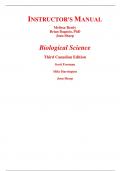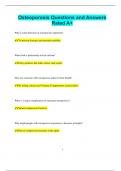INSTRUCTOR 'S MANUAL
Melissa Reedy Brian Bagatto, PhD Joan Sharp Biological Science Third Canadian Edition Scott Freeman Mike Harrington Joan Sharp Freeman, Biological Science, 3Ce, Introduction to the Instructor Guide − 2 © 2019 Pearson Canada , Inc. Getting the Most from This Instructor Guide The Instructor Guide provides resources to support student learning that will be useful for instructors using the Third Canadian Edition of Freeman/ Quillin/ Allison/ Black/ Podgorski/ Taylor/ Harrington/ Sharp , Biological Science . Learning Objectives The learning objectives outline key learning goals that define mastery of concepts from each chapter. Students can test themselves by addressing the learning objectives for topics covered in the ir course. Lecture Outline The lecture outline provides a brief summary of the material covered in each chapter, including chapter content , figures, and Canadian Issues and Canadian Research boxes. The outline may help instructors to determine reading assignments and to plan what material from the text they wish to address in the ir course . Chapter Vocabulary The chapter vocabulary list includes all terms that are relevant to material covered in the chapter, including terms that students may have encountered in previous chapters. Lecture Activities Lecture activities and discussion topics are provided for each chapter, providing instructors with tested ideas for active student learning to enhance student engagement and understanding. Lecture activities are very diverse. Designed for small group or full class interaction, activities include learning games, case studies with real -life applications to illustrate the relevance of course concepts, and challenges that require students to confront and correct biological misconceptions. A number of lecture activities allow students to practice the Bioskills , including graph and data interpretation, building and reading of phylogenetic trees, development of concept maps, combining probabilities, and other bioskills. Links are provided to video s and other online resources. Each lecture activity provides an estimate of the length of time required and potential questions to ask the students to support the activity. Discussion Idea s Small group and whole class discussion topics include debates on ethical issues , challenges to design biological apparatus , questions requiring critical thinking , and one -minute papers that require students to take a big -picture view of course material . Freeman, Biological Science, 3Ce, Chapter 1 Instructor Guide − 1 © 2019 Pearson Canada , Inc. Chapter 1 – Biology and the Tree of Life Learning Objectives: Students should be able to... •Name five fundamental characteristics shared by all living organisms.
•Describe the two components of the cell theory.
•Briefly explain the theory of natural selection, and clarify the two
conditions that are necessary and sufficient for natural selection to bring
about evolutionary change in a population .
•Explain the chromosome theory of inherita nce.
•Read a phylogenetic tree, and understand the role of similarities and
differences in constructing phylogenetic trees.
•Describe what biologists do ⎯that is, how they approach problems and
why they do experiments.
Lecture Outline I.What Does It Mean to Say That Something Is Alive?
•All living organisms share five fundamental traits:
1.Organisms are made up of membrane -bound cells.
2.Organisms replicate themselves.
3.Populations of organisms evolve.
4.Organisms have hereditary information encoded in genes.
5.Organisms acquire and use energy.
II.Life is Cellular
•Statement of the cell theory: All organisms are made of cells, and all cells
come from preexisting cells.
A.All organisms are made of cells
1.Cells were first described and identified in cork tissue (Hooke, 1665)
and in water and a variety of living tissues (van Leeuwenhoek). (Fig.
1.1)
2.All organisms are composed of cells, ranging in number from one to
many trillions.
3.A cell is an organized compartment bounded by a thin, flexible plasma
membrane and containing concentrated chemicals in an aqueous
solution.
4.Most chemical reactions important to life occur inside cells.
5.Cells reproduce via cell division.
B.Where do cells come from?
1.Spontaneous generation hypothesis versus all -cells-from-cells
hypothesis
a.Pasteur’s experiment supported the all -cells-from-cells hypothesis.
(Fig. 1.2)
b.Students should be able to identify problems that would have
arisen if Pasteur had not kept all variables except the one
being tested variable the same. Freeman, Biological Science, 3Ce, Chapter 1 Instructor Guide − 2 © 2019 Pearson Canada , Inc. C. Life replicates through cell division 1. All individuals in a population of single -celled organisms are related by ancestry. 2. All cells in a multicellular organism are also connected by common ancestry. III. Life Evolves A. What is evolution? 1. Species are related by common ancestry. 2. The characteristics of a species can be modified from generation to generation. 3. Darwin and Wallace (1858) proposed that this happens by natural selection. B. What is natural selection? 1. Natural selection occurs whenever two conditions are met: a. Individuals within a population vary in characteristics that are heritable. b. Certain heritable traits help individuals survi ve and produce offspring better in a particular environment than other heritable traits . 2. How do these two conditions lead to evolution? a. If certain heritable traits help individuals produce more offspring, then those traits become more common in the population over time. b. Natural selection acts on individuals, but evolutionary change occurs in populations. Examples of selection: (1) Beak shape and size in f inch populations on the Galápagos Islands have evolved by natural selection in response to changes in seed availability with varying rainfall. (2) Canadian Research 1 .1: Artificial selection on bighorn sheep in Alberta (i) Trophy hunting for bighorn sheep has resulted in artificial selection against large rams, leading to a decline in weight and horn length of four-year-old rams over time ( Fig. 1.9). 3. Students should be able to graph how a trait in a population would change over time under different conditions ⎯for example, average stem height in a plant population in a windy (short plants have an advantage) versus a nonwindy (tall plants have an advantage) environment. IV. Life Processes Information • Chromosome Theory of Inheritance : Inside cells, hereditary information is encoded by genes located on chromosomes. • A chromosome consists of a molecule of deoxyribonucleic acid (DNA) , a double -stranded helix (Fig. 1.4). A. The Central Dogma 1. DNA → RNA → Protein (Fig. 1.5) 2. DNA encodes a message in the sequence of its building blocks: A, T, C, and G. A pairs with T, C pairs with G.





